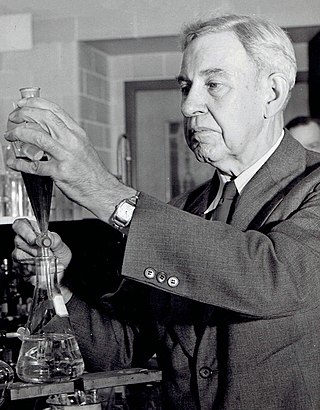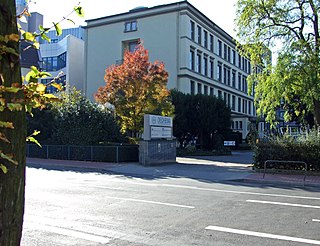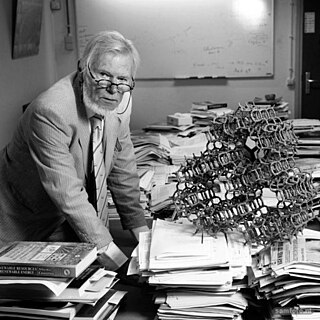
Jacobus Henricus "Henry" van 't Hoff Jr. was a Dutch physical chemist. A highly influential theoretical chemist of his time, van 't Hoff was the first winner of the Nobel Prize in Chemistry. His pioneering work helped found the modern theory of chemical affinity, chemical equilibrium, chemical kinetics, and chemical thermodynamics. In his 1874 pamphlet, van 't Hoff formulated the theory of the tetrahedral carbon atom and laid the foundations of stereochemistry. In 1875, he predicted the correct structures of allenes and cumulenes as well as their axial chirality. He is also widely considered one of the founders of physical chemistry as the discipline is known today.

Vladimir Nikolayevich Ipatieff ; was a Russian and American chemist. His most important contributions are in the field of petroleum chemistry and catalysts.
Physical Chemistry Chemical Physics is a weekly peer-reviewed scientific journal publishing research and review articles on any aspect of physical chemistry, chemical physics, and biophysical chemistry. It is published by the Royal Society of Chemistry on behalf of eighteen participating societies. The editor-in-chief is Anouk Rijs,.

DECHEMA is an abbreviation for "Deutsche Gesellschaft für chemisches Apparatewesen", though it has since been expanded to "Deutsche Gesellschaft für Chemische Technik und Biotechnologie".
Manfred Baerns was a German chemist.

Egbert (Bert) Willem Meijer is a Dutch organic chemist, known for his work in the fields of supramolecular chemistry, materials chemistry and polymer chemistry. Meijer, who is distinguished professor of Molecular Sciences at Eindhoven University of Technology (TU/e) and Academy Professor of the Royal Netherlands Academy of Arts and Sciences, is considered one of the founders of the field of supramolecular polymer chemistry. Meijer is a prolific author, sought-after academic lecturer and recipient of multiple awards in the fields of organic and polymer chemistry.
The Chemical Society of Japan (CSJ) is a learned society and professional association founded in 1878 in order to advance research in chemistry. The mission of the CSJ is to promote chemistry for science and industry in collaboration with other domestic and global societies.

The German Chemical Society is a learned society and professional association founded in 1949 to represent the interests of German chemists in local, national and international contexts. GDCh "brings together people working in chemistry and the molecular sciences and supports their striving for positive, sustainable scientific advance – for the good of humankind and the environment, and a future worth living for."

Prof. Dr. Avel·lí Corma i Canós is a Valencian (Spain) chemist distinguished for his world-leading work on heterogeneous catalysis.

Bernard Lucas Feringa is a Dutch synthetic organic chemist, specializing in molecular nanotechnology and homogeneous catalysis. He is the Jacobus van 't Hoff Distinguished Professor of Molecular Sciences, at the Stratingh Institute for Chemistry, University of Groningen, Netherlands, and an Academy Professor of the Royal Netherlands Academy of Arts and Sciences. He was awarded the 2016 Nobel Prize in Chemistry, together with Sir J. Fraser Stoddart and Jean-Pierre Sauvage, "for the design and synthesis of molecular machines".

Chemistry Europe is an organization of 16 chemical societies from 15 European countries, representing over 75,000 chemists. It publishes a family of academic chemistry journals, covering a broad range of disciplines.

Bert Marc Weckhuysen FRSC is a professor of inorganic chemistry and catalysis at Utrecht University, originally from Belgian descent. Weckhuysen is best known for his developments in operando (micro)spectroscopy; imaging catalysis at macro, meso and micro scales, from the reactor down to interactions between single atoms and molecules. He was a winner of the 2013 Spinoza Prize, and was knighted in the Order of the Netherlands Lion in 2015.

Nancy Beth Jackson was an American chemist. She did energy research on heterogeneous catalysis and the development of alternative fuels. She also worked in the field of chemical nonproliferation, educating chemical professionals on the importance of safe and secure chemical practice in research, teaching and business, in an effort to prevent the misuse of chemicals as "weapons, poisons, explosives or environmental pollutants". She was the first implementer in developing the international Chemical Security Engagement Program. She was active in promoting diversity in STEM fields. She was president of the American Chemical Society in 2011, leading the organization during the International Year of Chemistry. In 2012, she was honored with the AAAS Award for Science Diplomacy.

Javier Pérez-Ramírez is a Professor of Catalysis and Chemical Engineering at ETH Zurich.

The Chinese Chemical Society is a professional society of chemists headquartered in Beijing. It is part of the China Association for Science and Technology. Current membership is at around 55,000.

Herman van Bekkum was a Dutch organic chemist. He was professor of Catalysis in Organic Chemistry between 1971 and 1998 at Delft University of Technology. He served as rector magnificus of the university between 1975 and 1976. He was an expert in the field of carbohydrate chemistry and zeolites.
Hendrik Coenraad Prinsen Geerligs was a Dutch chemist and sugar technologist active in Java in the early part of the 20th century.

Sybren Otto is Professor of Systems chemistry at the Stratingh Institute for Chemistry, University of Groningen.

Martin Albrecht is a Swiss chemist. He is Professor of Inorganic Chemistry at the Department of Chemistry, Biochemistry and Pharmacy at the University of Bern. He is known for his contribution to carbene chemistry, particularly with his work on 1,2,3-triazolylidene mesoionic carbene.














